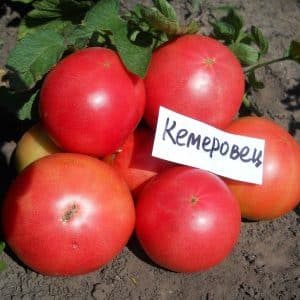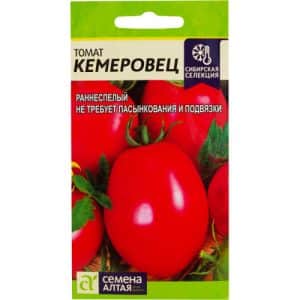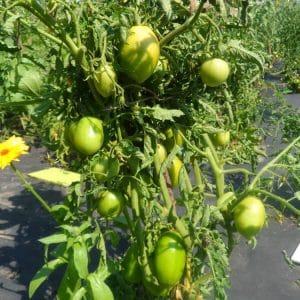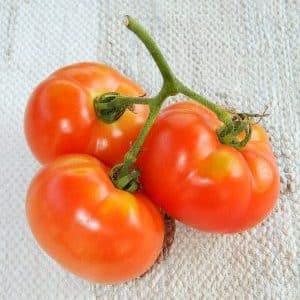A variety that you will definitely be satisfied with - the Kemerovo tomato and the secrets of proper care for it
Early ripening tomatoes are especially popular in our country. They are unpretentious in care, and some varieties produce a harvest as early as the end of June. Thanks to the efforts of domestic breeders, crops have appeared on the markets that are distinguished not only by early ripening, but also by cold resistance. They are grown in open ground even in Siberia.
Kemerovo is one of these tomatoes. It is distinguished by pink fruits with a rich taste, which is considered rare for cold-resistant early varieties. It also has other advantages, which we will discuss in detail below.
Description of the variety
Tomato Kemerovo is a variety bred by domestic breeders. It is included in the State Register of the Russian Federation and is adapted to the weather conditions of Siberia.
The variety appeared on horticultural markets in 2003. It is popular among gardeners from the central and northern regions of Russia. It is often planted by summer residents who prefer not to spend a lot of time caring for their plantings.
Distinctive features
Kemerovo tomatoes are low-growing varieties, their height is no more than 50 cm. The bushes do not require additional support or shaping. This makes caring for the plant much easier.
Another distinctive feature of the variety is its early ripening. Unlike many other early tomatoes, the fruits of Kemerovo have a rich sweet-sour taste with a pronounced aroma.
Its berries are pink. They are small, but have a beautiful heart-shaped shape.Contains iodine and lycopene.
Kemerovo is distinguished by its friendly maturation. It bears fruit quickly, so it does not suffer from late blight.
The immunity of the variety is average. If not properly cared for, other diseases will affect it.
The main positive feature of the variety is its resistance to cold weather. This is one of the few tomatoes that can grow outdoors in cities with extreme climates.
The photo shows the fruits of a cold-resistant variety.

Main characteristics
The Kemerovo tomato is ideal for growing in open ground conditions in regions with an optimal climate. It is popular not only for its ease of care and beautiful heart-shaped fruits: almost all of its characteristics are impressive - see the table for more details.
| Parameter | Indicators |
| Bush type | Determinant, standard. The height varies between 40-50 cm. The bushes are powerful, strong, branched. The leaves are ordinary, medium in size, dark green, without pubescence. Plants are covered with a medium amount of foliage. The inflorescences are simple. The first is laid at the level of 5-6 sheets, the next through each sheet. The fruits are formed in clusters. |
| Growing method | The tomato is cold-resistant. They are grown mainly in open ground. |
| Productivity | High. Up to 4 kg of tomatoes are harvested from one bush. Thanks to the possibility of thickened planting from 1 sq. m harvest more than 20 kg of crop. |
| Fruit | Small ones. The weight of each of them varies between 55-150 g. Individual specimens reach a weight of 200 g. The color is crimson inside and out. Some berries have a light spot at the base. Heart-shaped. There is light ribbing at the base. The tip is sharp and elongated. The taste of the fruit is sweet and sour, the aroma is rich tomato.The pulp is dense and juicy. Each berry has 4-5 seed chambers. |
| Transportability | High. The skin is dense, so the berries do not spoil during long-term transportation. They are stored for more than 1.5 months. |
| Ripening time | Early. The first harvest is harvested 95-105 days after sowing the seeds. |
| Disease resistance | Immunity is average. Due to its early ripeness, it is not afraid of late blight. |
How to grow seedlings
Early ripening tomatoes in the southern regions can also be grown without seedlings. In this case, the seeds are immediately sown in the ground. With this method of cultivating tomatoes, the harvest is obtained late.
The seedling method of growing tomatoes is suitable for all regions. It is this type of agricultural technology that allows you to get an early harvest.
Seeds for seedlings are sown 45-55 days before they are planted in a permanent place. The colder the climate, the later they start growing tomatoes. Depending on the region, the time for sowing planting material varies from early March to early April.
Seed preparation
Seeds of varietal tomatoes are collected independently or purchased at gardening stores. The endurance of plants largely depends on the quality of planting material.
The seeds are soaked in salted water (1 teaspoon of salt per 1 cup of water). Only those specimens that are capable of sprouting will sink to the bottom.
The seeds are disinfected. This stage will protect the plants in the future from infection by various infections. To do this, planting material is soaked in one of the following products:
- light pink solution potassium permanganate – for 20 minutes;
- hydrogen peroxide – for 15 minutes;
- “Fitosporin” – for 4 hours;
- aloe juice diluted in half with water - for 12 hours.
To speed up seed germination, increase cold resistance and immunity to negative environmental factors, they are soaked in a growth stimulator. They use both purchased formulations (Epin, Sodium Humate) and homemade products (aloe or potato juice).
Advice. Some gardeners deliberately do not process planting material, believing that the strongest plants are those grown from dry seeds.
Selection of containers and soil
The soil should be loose and contain nutrients. You can buy it at the store or prepare it yourself. Black soil is taken as the base, equal parts of humus and sawdust are added to it.
Reference. The most suitable soil mixture for seedlings is soil taken from the garden area where adult plants will grow. After planting, tomatoes adapt to such soil faster.
The soil is treated with a disinfectant composition: a dark pink solution of potassium permanganate, boiling water or copper sulfate. Some gardeners bake the soil in the oven.
Seeds of inexpensive tomatoes are usually sown in a common container. Special trays and boxes or cut-off bottles, disposable deep plates and other available containers are suitable.
When the seedlings grow, they are planted in individual pots. Use any deep container with a volume of 300-500 ml with drainage holes.
Containers are also disinfected. They are soaked for half an hour in a solution of potassium permanganate.
Sowing
To speed up seed germination (in 2-3 days), moisten a cotton cloth with water, lay the seeds on it, leaving small distances between them. The top of the planting material is covered with a damp cloth or paper.Containers with blanks are placed in a warm place, adding water as needed.
The hatched seeds are sown into separate cups using tweezers (it is better to use peat cups; they are lowered into the ground along with the seedlings). Deepen by 1 cm, no more.
Most gardeners simply sow the treated seeds in rows in boxes filled with soil. They are sprinkled with a centimeter layer of earth on top. The soil is moistened with a spray bottle.
Containers with planting material are covered with film and put in a warm place. Every 2 days the film is opened slightly for ventilation, and the soil is moistened.
Growing and care
Some gardeners grow seedlings in a heated greenhouse. During the day, the temperature is raised to 23-25 ° C and the backlight is turned on. At night, the temperature is reduced by a few degrees and the lamps are turned off. The seedlings turn out strong and squat.
Note! It is important to prevent high air humidity in the greenhouse, as this can provoke various diseases. Ideal humidity is 60-65%.
If there is no greenhouse, seedlings are grown on the windowsill. Room temperature is suitable for tomatoes, but there is not always enough natural light in early spring. In this case, fluorescent lamps are used.
Water the plants as the top layer of soil dries. Gardeners recommend using water at a temperature of at least +20 °C and avoiding water getting on the leaves so that they do not rot.
Feed the seedlings 3 times:
- two weeks after picking into individual containers (this procedure is carried out after two true leaves appear on the plants);
- 14 days after the previous feeding;
- 5 days before diving into the ground.
Potassium and phosphorus are used as fertilizing.These fertilizers will help grow seedlings with a strong root system.
How to grow tomatoes
Two weeks before picking, the seedlings begin to harden. To do this, plants are taken out to the balcony or outside every day. The first time - for 30 minutes, then increase the time daily, bringing the hardening duration to 16 hours.
5 days before picking, the plants are watered and fed. This will help the seedlings quickly take root in their new location.
Plants are planted in open ground when the soil warms up to +12 °C at a depth of 15 cm.
Landing in a permanent place
Before planting seedlings, the holes are prepared. This is done in the fall:
- the beds are dug up and cleared of weeds;
- for every 1 sq. m add 6 kg of manure or humus;
- crushed tomato tops treated with a solution of potassium permanganate are buried in the soil;
- check the acidity of the soil with litmus paper and, if necessary, add ash;
- if the soil is heavy, the soil is mixed with sand.
In the spring, the soil is dug up again. It is poured with copper sulfate. To prepare a solution, take 1 tbsp per 10 liters of water. l. vitriol.
The holes are dug in rows in a checkerboard pattern. For 1 sq. m place from 5 to 9 plants. The Kemerovo resident accepts thickened plantings.
A handful of ash or long-acting granular fertilizers are poured into the bottom of the hole. 1 liter of water is poured into each well. After the liquid is absorbed, the seedlings are planted. The depressions are filled with soil, which is compacted.
Plant care
The Kemerovo variety is not needed tie up. Its bushes are low and strong and do not break under the weight of the fruit.
It is also not necessary to form a plant. Only yellowed and withered foliage is removed from the bushes.
Advice. Some gardeners still prefer to remove foliage before the first flower cluster. In this case, the fruits are larger.
Water the tomatoes as the top layer of soil dries with water at room temperature. This is done in the morning or at sunset. During the watering process, make sure that the liquid does not fall on the above-ground part of the plants.
After each glaze and precipitation loosen the soil. This helps to destroy the earthen crust that impedes air exchange. During the loosening process, weeds are removed.
They feed tomatoes 2 times per season. The first time is two weeks after disembarkation, the second time is another 2-3 weeks later.
Useful tips from gardeners
Experienced farmers know several tricks to get a rich harvest and avoid many problems:
- Agronomists advise avoiding nitrogen-containing fertilizers, since nitrogen provokes abundant growth of foliage and the fruits become small and tasteless.
- After planting the tomatoes in a permanent place, the beds are mulched with hay, straw or humus. This layer protects against frost, pests and diseases.
- Ugly inflorescences need to be removed. They will interfere with the formation of high-quality fruits.
- Incomplete ripening of tomatoes is associated with a lack of sunlight due to dense plantings or a lack of fertilizers.
Diseases and pests
The variety is not susceptible to late blight, the main enemy of plants in the nightshade family. But some diseases still affect him:
- Powdery mildew is a fungal disease that forms a white coating on leaves and flowers that turn yellow and fall off. The plant is treated with fungicides (Topaz, Teovit Jet, Skor).
- Mosaic. Dark spots appear on the leaves and deformation of the fruit occurs.To prevent disease, remove affected leaves and fruits.
- Bacterial wilt. Brown or yellow rings with pathogenic mucus appear on the stem of the plant. Bacteria spread from the soil. To combat the disease, the affected plant must be destroyed.
To protect tomatoes from insects, the bushes are treated with a soap solution (1 piece per bucket of water) or wormwood solution. Chemical preparations are also used, for example, “Barrier”.
The nuances of growing in open ground and in greenhouses
The Kemerovo variety is unpretentious in cultivation. Care for adult plants is kept to a minimum.
Seedlings are planted in open ground at the beginning of May in the southern regions and at the beginning of June in the northern regions. In the event of a sudden cold snap, it is recommended to cover the plantings with spanboard or film.
Features of growing in open ground:
- The planting site must be protected from the wind;
- It is not recommended to plant in the area where other nightshades (eggplants, potatoes) had previously grown;
- Seedlings are planted in open ground in the late afternoon;
- watering abundantly, 2-3 times a week.
In a greenhouse, care involves regular watering and ventilation to avoid mold and the spread of disease.
Features of growing in greenhouses:
- seedling height for quick adaptation - no more than 6 cm;
- watering – once a week;
- the use of artificial pollination (shaking flowering bushes);
- It is better to plant in the dark and in cloudy weather.
Carefully! If you do not protect the seedlings from direct sunlight, the shoots will burn.
Harvesting and application
Kemerovo tomato fruits ripen at the same time. They are plucked from the bush with tassels or individually. At a temperature of no more than +30 °C, tomatoes are stored for 1-2 months.
The fruits are processed into tomato juice, paste, salted and pickled. When preserved, they retain their sweet and sour taste. Used in salads and fresh.
Advantages and disadvantages of the variety
Farmers note the almost complete absence of shortcomings in the variety, while talking about the advantages:
- harvesting is possible throughout the season;
- early ripening;
- does not have time to become infected with late blight;
- does not require pinching and does not require garter;
- long-term storage of crops;
- grown both in open and closed ground;
- withstands low temperatures.
The variety has no significant disadvantages.
Farmer reviews
Reviews from gardeners are mostly positive. Most note the sweet taste, fleshiness of the fruit and ease of care.
Alena, Shumerlya: “I fell in love with Kemerovo at first sight. The appearance is perfect, just like in the photos of advertising brochures. The seeds of the fruit are large and few in number. There are no problems when growing, the plants are unpretentious and are not afraid of frost. The taste is excellent. The best early ripening variety."
Evgeniy, Voronezh: “This is not the first year I have been growing Kemerovo. I plant a few bushes so that before the sweeter and larger mid-season varieties ripen, I will have my own tomatoes on the table. The variety is easy to grow; I plant it at the dacha. Requires minimal maintenance. Tomatoes are also good when marinated. There is enough harvest from nine bushes for both food and canning.”
Conclusion
The Kemerovo variety is an excellent option for summer residents and beginners. He is not afraid of cold weather, late blight, and does not need gartering or pinching. It requires minimal care and copes with most adverse environmental factors.
An experienced farmer will also like this variety.It ripens early and produces heart-shaped fruits with a rich taste.